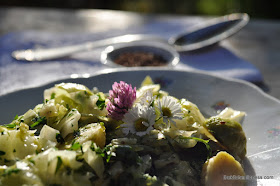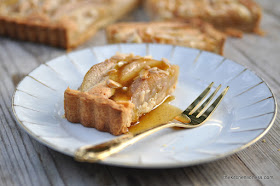The month of October marks the eighteenth month of our international online cooking group, The Cottage Cooking Club. As a group, recipe by recipe, we are cooking and learning our way through a wonderful vegetable cookbook written in 2011 by Hugh Fearnley-Whittingstall, entitled „River Cottage Everyday Veg".
One of the declared aims of our cooking group is to make a decided effort to use as much regional, organic and also seasonal produce as is reasonably possible.
This month I prepared seven of the ten designated recipes. I will write about each dish in the order in which I prepared them.
My first recipe for this October post is the colorful Beetroot with walnut and cumin (page 113) from the chapter "Raw Assemblies“.
Instead of grating the raw beetroot and let it sit in the marinade for a good thirty minutes, I used thin slices and let them macerate for a good two hours before serving - I used two types of beets here - the chioggia beet aka the candy stripe beet as well as the red beets. Although the slices of beets sit in a lovely marinade of freshly squeezed lemon and orange juice, and receive a nice sprinkling of bashed local walnuts and toasted cumin seeds and a topping of fresh chives, they most definitely retain their deep earthy flavor. A very pretty, not-your-everyday-type of side dish or appetizer. Elegant and special.
For the second recipe this month I chose the Orecchiette with chickpeas and cavolo nero (page 261) from the chapter "Pasta & Rice". This recipe has become my go-to recipe for a rather quick and easy pasta dish. It is such a versatile base recipe with but a few good ingredients.
This dish makes my home crowd extremely happy every time I prepare it. The first time I made this (you can take a look
here), I used
spring arugula and a fun-shaped pasta called "
Ufo pasta". This time a used some
Creste di gallo pasta from my Italian market
, fresh
spinach, chickpeas, banana shallots (this is the largest variety of shallots and slightly milder than other types of shallots)
. rose garlic (my favorite garlic) and a good pinch of freshly ground
cumin. Nice flavors and I must say that pasta mixed with chickpeas and greens is also very satisfying, no additional grating of Parmigiano Reggiano required.

The third recipe that go my attention this month was the Porotos granados (page 146 ), from the chapter „Hefty Soups“. This traditional Chilean squash and bean stew is a rather hearty dish, perfect for this time of year. Other than an onion, garlic, Spanish sweet smoked paprika, fresh oregano, cannellini beans (in my case), homemade vegetable stock (page 130), a bay leaf from my garden, butternut squash, French beans, and corn, all you need is freshly ground black pepper, sea salt and a really good appetite.
Lots of veggies here and lots of color to please the eye - pure comfort-food in a bowl and a nice change from traditional heavy stews. It actually does gain from preparing it well in advance and giving the different flavors a chance to deepen and for the stew to thicken.
The fourth recipe has a very tasty Asian touch - nice for those fall veggies. Grilled aubergines with chili and honey (page 340) from the chapter "Roast, Grill & Barbecue" - this is a recipe that I had been looking forward to preparing for the longest time as the diversity in flavors seemed to be very appealing to me. And I was not disappointed.
The combination of peeled and grilled aubergine slices, local runny honey, lemon, chili and fresh thyme is very nice and full of contrasts that pleased my palate - next time I would love to serve this dish as part of an Asian inspired spread.
The
fifth recipe was
Garlic and caraway (fall) greens (page 372) from the chapter "
Side Dishes". Another one of those very versatile and easy recipes that I so enjoy from this book, this time a side dish. And a variation of the
Steamed veg with a hint of garlic that I prepared in June of last year using French beans, broccoli, freshly shelled peas, broad beans and green asparagus (you can take a look
here).- how seasons can seriously change the appearance and taste of dish!
The greens I chose for my October version were Brussels sprouts and sweetheart cabbage, a seasonal, mild and tender cabbage that is wildly available at this time of year. We really liked both versions and I believe this would be also great with some left-over greens.
Adding lightly bashed caraway seeds to your greens, especially cabbage, is said to aid digestion - we eat quite a bit of caraway around here (especially in Bavaria) but I do realize that it is somewhat of an acquired taste.
Recipe number six this month was the Basil and mozzarella tart (page 216) from the chapter "Store-Cupboard Suppers". If you really need another argument why you should always make sure to keep some fresh or frozen good-quality ready-made puff pastry at the ready, than this tart is it.

Loaded with the well-known ingredients of an
Insalata caprese, this tart really showcases that simple is often best. I have prepraed this recipe smore times than I can count. For the October line-up, I chose some deliciously tangy
buffalo mozzarella, beefsteak tomatoes and fresh basil - heaven. And this tart works equally well with goat´s cheese, some type of blue cheese, Pecorino Romano or Parmigiano Reggiano. And do not forget to have fun with the different herb options - use
thyme or
rosemary or even
chives here - oh, the possibilities. For my
goat´s cheese and thyme version of this tart, please take a look
here. And for my
mozzarella and thyme version, take a look
here. As you probably guessed it, we are seriously addicted to this tart recipe.
Last but not least, the seventh recipe for the month of October was the Cauliflower and chickpea curry (page 27) from the chapter "Comfort Food & Feasts".
For this curry you should go the extra mile and use freshly ground spices, not a ready-made curry powder, although, of course, that is an option for this recipe. Add freshly grated ginger, ground coriander, cumin, dried chili, garam masala (typical ingredients for a garam masala are black peppercorns, mace, cinnamon, cloves, brown cardamom, nutmeg, green cardamom). and some star anise and you will delighted with the depth of flavor that all these warm spices lend to this dish.
I decided to serve some basmati rice with yellow and black sesame seeds alongside - to make this a more substantial dish.
Then some oven-roasted chickpeas for some extra crunch and as a little nibble - not bad, if I may say so myself.
In summary, another month full of wonderful vegetable dishes – this month we were delighted to enjoy a number of hearty fall recipes, main courses as well as side dishes or appetizer) for lunch and dinner. What can possibly be better than to cook with seasonal ingredients even at this time of year.
Please note, that for copyright reasons, we do NOT publish the recipes. If you enjoy the recipes in our series, hopefully, the wonderfully talented and enthusiastic members of The Cottage Cooking Club and their wonderful posts can convince you to get a copy of this lovely book. Better yet, do make sure to join us in this cooking adventure.
To see how wonderful all the dishes from my fellow
Cottage Cooking Club members turned out this month, please visit
here. They would all appreciate a visit!












































